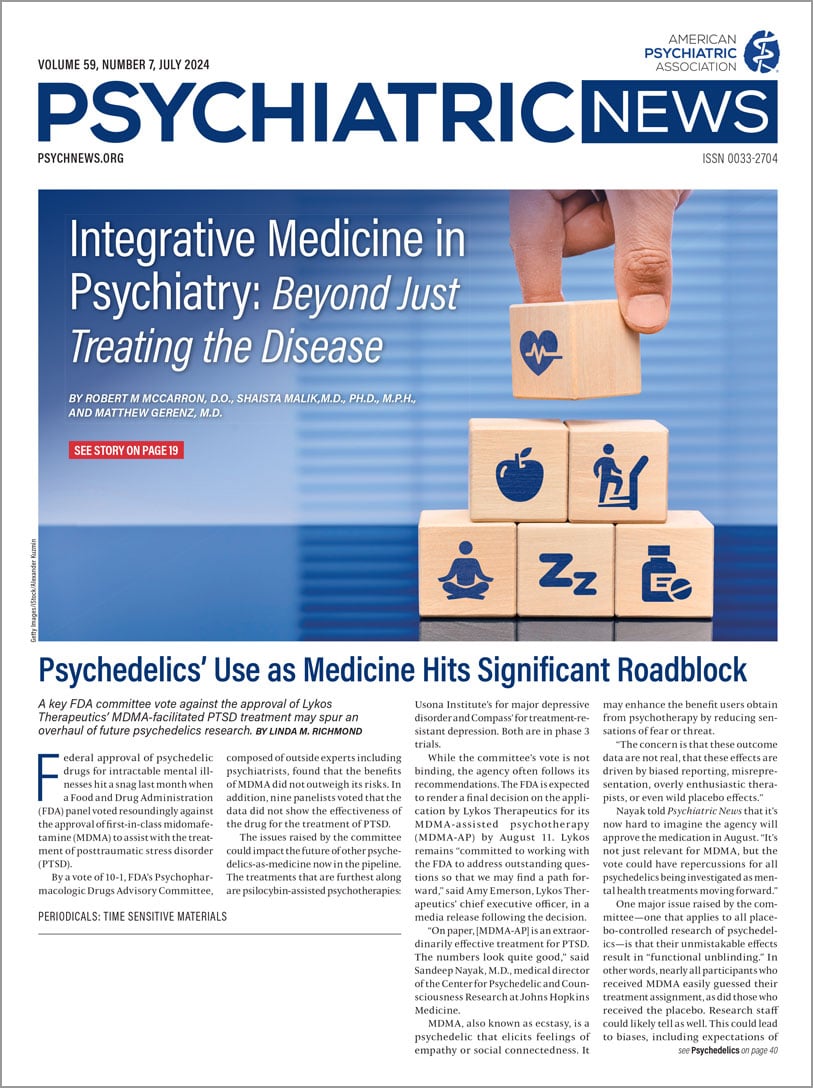The risk of agranulocytosis—a severe loss of white blood cells—among people taking clozapine is minimal and drops steeply after the first year of use, according to a recent population study published in Lancet Psychiatry.
This epidemiological study tracked 62,000 people in Finland with schizophrenia or schizoaffective disorder, of whom one quarter took clozapine and three-quarters took other antipsychotics. Over a follow-up as long as 22 years, 1.37% of patients developed clozapine-induced agranulocytosis, compared to 0.13% of those taking other antipsychotics.
“The vast majority of agranulocytosis cases occur at the very beginning of clozapine treatment— more than half during the first six months,” lead author Jose M. Rubio, M.D., Ph.D., a research psychiatrist in the Department of Psychiatry at Zucker Hillside Hospital in New York, told Psychiatric News. “Yet the requirements for lifetime blood monitoring deter some patients from taking clozapine, which can be a lifesaving medication.”
Since its first approval 35 years ago, clozapine has remained the gold standard and the sole approved medication for the treatment of refractory schizophrenia; clozapine was subsequently approved to treat suicidality in individuals with schizophrenia or schizoaffective disorder more than two decades ago. Yet while about 33% of people with schizophrenia have treatment-resistant illness, clozapine accounted for just 4.8% of antipsychotic fills in the U.S. Medicaid program from 2006 to 2009.
The recent data were published as the Food and Drug Administration (FDA) considers changes to its clozapine Risk Evaluation and Mitigation Strategy (REMS). Following pressure from APA and other advocacy organizations, the agency announced in late April that it will hold an
in-person meeting of its clozapine REMS advisory committee this fall to obtain advice about “possible changes to the Clozapine REMS to minimize burden on patients, pharmacies, and prescribers.”
FDA also expects to obtain results this year from three ongoing U.S. studies it is funding or collaborating on that involve clozapine utilization, adherence to the REMS, and clinical outcomes, including agranulocytosis and less severe forms of blood cell loss, or neutropenia.
“FDA should consider that risk mitigation strategies that are so stringent that they deter the use of clozapine are counterproductive. Not using clozapine in eligible individuals may be more dangerous than using it, given what we know the low risk of clozapine-induced agranulocytosis and the prolonged life expectancy associated with clozapine,” Rubio added.
“The efficacy of clozapine is unrivaled,” Joseph F. Goldberg, M.D., clinical professor of Psychiatry at the Icahn School of Medicine at Mount Sinai, told Psychiatric News, noting that clozapine has one of the largest effect sizes among psychiatric medications. “Yet, many practitioners do not prescribe it because of concerns that its side effects seem unwieldy to manage, and its monitoring schedule for agranulocytosis too onerous to implement.”
This new study “provides much-needed data, and encouragement, that the actual risk for clozapine-associated agranulocytosis may decline significantly after six months…These findings will no doubt be helpful in FDA’s deliberations,” Goldberg added. “These efforts must properly and fairly balance drug safety with efficacy, alongside the need for practical manageability based on actual, more than theoretical, risks.”
Clozapine Risk Lessens Over Time
Rubio and colleagues found that antipsychotics as a class appear to be associated with an elevated risk of agranulocytosis during the initial six months of treatment.
However, the risk appears to abate after six months among those taking other antipsychotics. With clozapine, the risk of agranulocytosis drops sharply over time, but remains persistently greater (4-fold higher after 54 months or more of treatment) than with other antipsychotics.
Other results include the following:
•
Among the 231 people who developed clozapine-induced agranulocytosis, 76 were rechallenged with a second clozapine trial, and just 11 developed the condition for a second time (14%).
•
The agranulocytosis fatality rate was 2.81 per 10,000 individuals taking clozapine and 0.63 per 10,000 of those taking other antipsychotics.
Rubio and colleagues note that this relative risk should be put into perspective, “the low rates of absolute cumulative incidence, recurrence, and fatality of clozapine-induced agranulocytosis should be weighed against its clear superiority in symptom, function, and mortality-related outcomes.”
Rubio pointed out that while the FDA has generated a lot of patient safety data through its clozapine monitoring program over the past decade, most researchers cannot access it. “My call to the FDA is to make that data accessible to researchers so we can better examine the risks in the U.S. population,” he said.
The Finnish study comes on the heels of an epidemiologic study in November 2023 that reported similar results among individuals with schizophrenia in New Zealand and Australia: most serious neutropenia leading to clozapine cessation in occurred within the first 18 weeks of treatment. Furthermore, the risk was negligible after two years, according to that report from Korinne Northwood, MBBS, Ph.D., and colleagues, also in Lancet Psychiatry. They found only 1.2% had serious neutropenia leading to cessation (313 people among 26,300 taking clozapine). Furthermore, previous exposure to clozapine reduced the risk.
“Weekly hematological monitoring after the first 18 weeks could be safely reduced to once every four weeks and ceased after two years unless clinically indicated,” Northwood and colleagues concluded.
Obstacles To Clozapine Use
Prescribers have long called for more discretion on obtaining blood draws based on a patient’s circumstances, Frederick C. Nucifora Jr. Ph.D., D.O., M.H.S., program director of the Clozapine Clinic at Johns Hopkins Bayview Medical Center, told Psychiatric News. “As it stands now, patients who are unable to get regular blood draws are not permitted to take clozapine. Often it is the only medication that will help them.
“If a patient misses one blood draw, the patient cannot obtain a refill, and that interruption in clozapine often leads to worsening of symptoms and the possibility of hospitalization. There should be provisions for these situations,” added Nucifora, who is also an associate professor of Psychiatry and Behavioral Sciences at the Johns Hopkins School of Medicine.
The FDA’s REMS is just one of several obstacles to wider clozapine utilization. Nucifora said psychiatrists also need to become more comfortable prescribing clozapine and recognizing and managing its potential side effects, which can also include cardiac problems, paralytic ileus, and excess salivation. “Psychiatrists often overestimate the frequency of these side effects, especially severe neutropenia, and think that patients will not tolerate clozapine or be willing to get blood draws. However, there is evidence to suggest that patients do better and prefer to be on clozapine.”
Rubio said that aside from the REMS, other challenges include a lack of training in psychiatry resident programs on initiating and managing patients on clozapine. Other roadblocks include practices’ lack of ability to do onsite bloodwork and lack of access to a medical consultant.
Still, Rubio remains hopeful that the push to decrease regulations and remove administrative burdens will result in real change. “I see that there’s a growing interest in addressing the underutilization of clozapine. I think this is an area in which we can improve the lives of people living with treatment-resistant schizophrenia tremendously, if we to help patients obtain this drug whenever it is indicated.” ■



